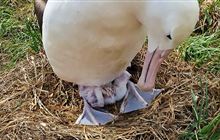New albatross ambassador needs a name
Archived content: This media release was accurate on the date of publication.
Introduction
Northern royal albatross/toroa is back in the spotlight as a new Royal Cam star prepares to take to the skies this summer.Date: 23 July 2019
Back by popular demand, the annual competition to name a northern royal chick at Pukekura/Taiaroa Head is now in its fourth year.
“Joining Moana, Tūmanako and Amīria before her, this young albatross is an ambassador not just for her species, but seabirds everywhere. She needs a name to reflect her special status,” says DOC biodiversity ranger, Sharyn Broni.
Royal Cam has grown in popularity over the past four years, totalling more than 3.4 million views on YouTube from 198 countries. An entranced audience has left more than 140,000 comments on the Royal Cam chat forum.
“Soon after she receives her new name, this chick will be flying 9000 km across the Pacific Ocean to the squid rich waters of the Humboldt Current near South America,” says Sharyn.
The northern royal albatross faces a variety of threats and challenges when it leaves the safety of the Southern Hemisphere’s only mainland colony, including plastics and the growing impact of climate change on ocean temperatures and feeding grounds.
“We’ve previously collected plastic fragments that birds have swallowed in the ocean. It’s sad to see the impact of human behaviour on birds so close to home, but this is the reality of what these birds are dealing with once they leave the sanctuary of Taiaroa Head,” says Sharyn.
If ingested, plastic can cause blockages in the gut, especially in the tight gizzard area between the stomach and the small intestine. Last year, all four regurgitations collected from pre-fledging chicks contained plastic that had been fed to them by their parents.
Royal Albatross Centre staff collect more than 6 kg of plastic rubbish every month at Pilots beach, below the albatross sanctuary.
“Plastic is among the most pressing threats to seabirds globally. It gets into the ocean by the millions of tonnes a year, breaks down into bite-sized chunks, and ends up smelling just like an albatross feast. 90 % of seabirds have been found to consume plastic.”
The Royal Cam chick has the tough task of drawing attention to the plight she and other seabirds are facing.
Taiaroa Head is home to estimated 10,000 other seabirds, including nationally vulnerable and threatened species like red-billed gulls and Otago shags. Royal Albatross Centre Marketing Manager, Sophie Barker says the Royal Cam chick is an amazing ambassador for marine birdlife.
“Each week we have eager fans visiting our tours and making changes to their lives after they learn of the threats to her environment. We’re very excited to find out her name!”
The Royal Cam competition launches today and runs for one week. People can learn more about the competition and enter on our website.
Contact
For media enquiries contact:
Email: media@doc.govt.nz

